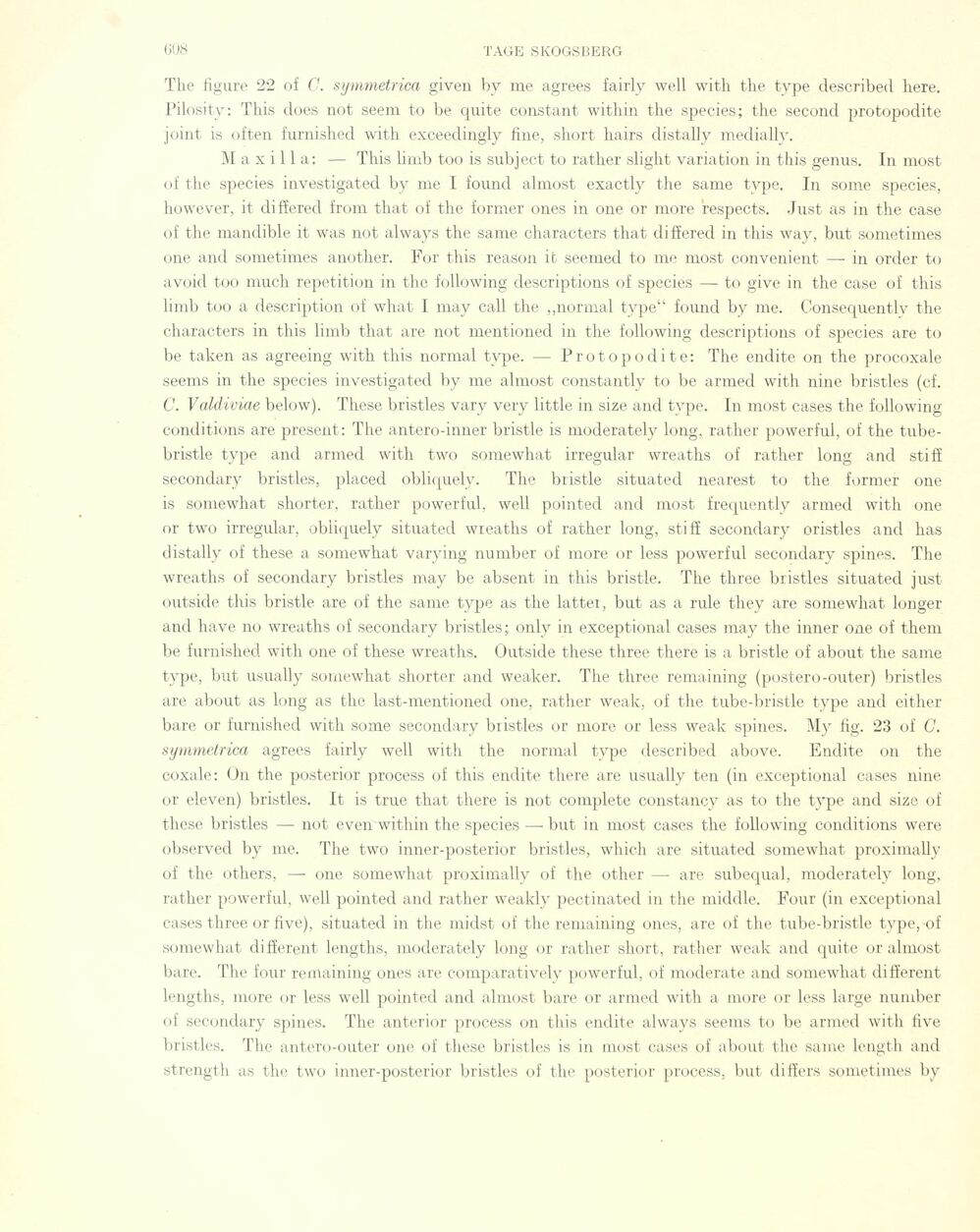
Full resolution (JPEG) - On this page / på denna sida - Sidor ...

<< prev. page << föreg. sida << >> nästa sida >> next page >>
Below is the raw OCR text
from the above scanned image.
Do you see an error? Proofread the page now!
Här nedan syns maskintolkade texten från faksimilbilden ovan.
Ser du något fel? Korrekturläs sidan nu!
This page has never been proofread. / Denna sida har aldrig korrekturlästs.
The figure 22 of C. symmetrica given hy nae agrees fairly well with the type described here.
Pilosity: This does not seem to be quite constant within the species; the second protopodite
joint is often furnished with exceedingly fine, short hairs distally medially.
Maxilla: — This limb too is subject to rather slight variation in this genus. In most
of the species investigated by me I found almost exactly the same type. In some species,
however, it differed from that of the former ones in one or more respects. Just as in the case
of the mandible it was not always the same characters tliat differed in this way, but sometimes
one and sometimes another. For this reason it seemed to me most convenient — in order to
avoid too much repetition in the following descriptions of species — to give in the case of this
limb too a description of what I may call the „normal type“ found by me. Consequentlv the
characters in this limb that are not mentioned in the following descriptions of species are to
be taken as agreeing with this normal type. —- Protopodite: The endite on the procoxale
seems in the species investigated by me almost constantly to be armed with nine bristles (cf.
C. Valdiviae below). These bristles vary very little in size and type. In most cases the following
conditions are present: The antero-inner bristle is moderately long, rather powerful, of the
tube-bristle type and armed with two somewhat irregulär wreaths of rather long and stifî
secondary bristles, placed obliquely. The bristle situated nearest to the former one
is somewhat shorter, rather powerful, well pointed and most frequently armed with one
or two irregulär, obliquely situated wreaths of rather long, stifî secondary oristles and bas
distally of these a somewhat varying number of more or less powerful secondary spines. The
wreaths of secondary bristles may be absent in this bristle. The three bristles situated just
outside this bristle are of the same type as the latter, but as a rule they are somewhat longer
and have no wreaths of secondary bristles; only in exceptional cases may the inner one of them
be furnished with one of these wreaths. Outside these three there is a bristle of about the same
type, but usually somewhat shorter and weaker. The three remaining (postero-outer) bristles
are about as long as the last-mentioned one, rather weak, of the tube-bristle type and either
bare or furnished with some secondary bristles or more or less weak spines. My fig. 23 of G.
symmetrica agrees fairly well with the normal type described above. Endite on the
coxale: On the posterior process of this endite there are usually ten (in exceptional cases nine
or eleven) bristles. It is true that there is not complete constancy as to the type and size of
these bristles — not even within the species —- but in most cases the following conditions were
observed by me. The two inner-posterior bristles, wliich are situated somewhat proximally
of the others, —- one somewhat proximally of the other — are subequal, moderately long,
rather powerful, well pointed and rather weakly pectinated in the middle. Four (in exceptional
cases three or five), situated in the midst of the remaining ones, are of the tube-bristle type, of
somewhat different lengths, moderately long or rather short, rather weak and quite or almost
bare. The four remaining ones are comparatively powerful, of moderate and somewhat different
lengths, more or less well pointed and almost bare or armed with a more or less large number
of secondary spines. The anterior process on this endite always seems to be armed with five
bristles. The antero-outer one of these bristles is in most cases of about the same length and
strength as the two inner-posterior bristles of the posterior process, but differs sometimes by
<< prev. page << föreg. sida << >> nästa sida >> next page >>